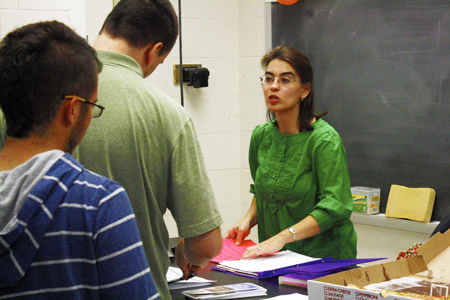November 2014
 |
Glenda Denicolo of the physical sciences department advises science majors. |
Science fiction author Frank Herbert once observed, “Deep in the human unconscious is a pervasive need for a logical universe that makes sense. But the real universe is always one step beyond logic.” This view informs not only his novel Dune but also provided the inspiration for Glenda Denicolo, assistant professor of physical sciences on the Ammerman campus, to become an astrophysicist. Glenda started at SCCC in 2007 as an instructor and now teaches physics and the occasional astronomy class.
She is Brazilian, and her bachelor’s degree is in physics from a Brazilian university. Science and academics are a family affair as Glenda’s father was a physics professor as well. Encouraged to pursue her love of science, Glenda had the opportunity to get involved in astronomy research early on. She spent two months observing the Hale-Bopp comet at the Canary Islands Institute of Astrophysics in 1996, received her masters in astronomy in Rio de Janeiro and moved to Cambridge, UK, for a PhD at the Institute of Astronomy. She met her husband during a post-doctoral researcher appointment in Santa Cruz, CA.
When it comes to teaching, Glenda appreciates the different challenges that each class presents. She is most excited when the challenge involves critically thinking about science. The higher-level physics courses, such as PHY245, use more sophisticated mathematical tools that allow students to derive physical principles step by step with no “magic” involved. Glenda feels particularly satisfied when her students properly appreciate a moment of eureka. Being an eternal student, the essence of what Glenda appreciates is learning in all its diverse forms.
In the past six years, she has noticed gradual changes in course profiles (generational, technological, economical) and is committed to applying different teaching tools for these shifting demographics. Glenda loves pedagogical experimentation and figuring out what works best for the myriad of SCCC students. Her goal is to tell a connected story, to link the mental reasoning process, and to induce further curiosity and independent thinking. She abhors a disconnected knowledge of physics, avoiding treating the subject as bunch of trivia to memorize. Glenda’s quest is to help students see it as an intelligible whole.
One of her techniques is including demonstrations during the lectures, splitting class hours for theory (lecture) and experimentation/demonstration (laboratory). Glenda’s philosophy is that learning occurs much more efficiently—and it is more fun—when experiment and theory take place side by side. She promises her students that she will teach them how to use certain tools (physical principles, concepts, equations, and mathematical techniques) but the only way to learn is through practicing with those tools and not memorization. This student-centered approach has labeled Glenda as a helpful and accessible professor in and outside of class, as she also organizes the schedule of the physical sciences help center and is the faculty advisor of the physics club.
Even when she’s away from SCCC, Glenda is immersed in her field. Her husband also teaches physics and astronomy, and they talk about science news and share curious information. They attend public talks together and sometimes are judges at the same science fair. Her father-in-law loves to talk about science and is an avid reader of science fiction. When Glenda’s husband gives public talks, it is a true family affair; they all get together (including their dog) to watch and show their support.
This solidarity can also be seen in Glenda’s thoughts on the Faculty Association, as it’s an important institution that she fully supports. Though she has a “very healthy and rather common allergy to politics,” she appreciates the political action that the FA engages in on her behalf.
Currently, Glenda is involved in research with Prof. Frederick M. Walter at Stony Brook University and is hoping that the project will flourish to the point where she can involve students in data analysis and research. She is also excited about the “beautiful” telescope dome installed on the rooftop of the Smithtown Science building and, together with Professors Inglis and Pappas, would like to help increase student involvement in astronomy observation and research.
In terms of teaching, Glenda would like to offer a course on modern physics and to further explore video analysis in class and as out-of-class experiments or research projects. She already uses the analysis of the motion of objects in videos to derive position/velocity/acceleration versus time graphs in class and believes many more physical laws could be demonstrated using video analysis. For the future, she would like to design a hybrid online course for physics with a face-to-face laboratory component.
We should all envy Glenda’s students as she boldly takes them where no physics teacher has gone before.
